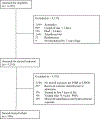Association of time of first corticosteroid treatment with bronchopulmonary dysplasia in preterm infants
- PMID: 34379886
- PMCID: PMC8453128
- DOI: 10.1002/ppul.25610
Association of time of first corticosteroid treatment with bronchopulmonary dysplasia in preterm infants
Abstract
Objective: To evaluate the association between the time of first systemic corticosteroid initiation and bronchopulmonary dysplasia (BPD) in preterm infants.
Study design: A multi-center retrospective cohort study from January 2010 to December 2016 using the Children's Hospitals Neonatal Database and Pediatric Health Information System database was conducted. The study population included preterm infants <32 weeks' gestation treated with systemic corticosteroids after 7 days of age and before 34 weeks' postmenstrual age. Stepwise multivariable logistic regression was used to assess the association between timing of corticosteroid initiation and the development of Grade 2 or 3 BPD as defined by the 2019 Neonatal Research Network criteria.
Results: We identified 598 corticosteroid-treated infants (median gestational age 25 weeks, median birth weight 760 g). Of these, 47% (280 of 598) were first treated at 8-21 days, 25% (148 of 598) were first treated at 22-35 days, 14% (86 of 598) were first treated at 36-49 days, and 14% (84 of 598) were first treated at >50 days. Infants first treated at 36-49 days (aOR 2.0, 95% CI 1.1-3.7) and >50 days (aOR 1.9, 95% CI 1.04-3.3) had higher independent odds of developing Grade 2 or 3 BPD when compared to infants treated at 8-21 days after adjusting for birth characteristics, admission characteristics, center, and co-morbidities.
Conclusions: Among preterm infants treated with systemic corticosteroids in routine clinical practice, later initiation of treatment was associated with a higher likelihood to develop Grade 2 or 3 BPD when compared to earlier treatment.
Keywords: CHNC; chronic lung disease; dexamethasone; hydrocortisone; prematurity.
© 2021 Wiley Periodicals LLC.
Conflict of interest statement
The authors have no conflicts of interest.
Figures




References
Publication types
MeSH terms
Substances
Grants and funding
LinkOut - more resources
Full Text Sources

